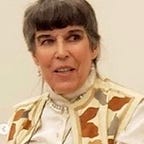Hat Engineering Project for Elementary Education
Illumination of 2D, 3D, 4D transformation engineering
From the age of 12, until today at 87, I have been fascinated by dimensional concepts, in math, engineering, industry and philosophy. It started with studying the 2D fabric pieces that would be sewn together into 3D clothing, and how to obtain the 2D pattern pieces that would make the 3D idea in my head into reality.
My greatest enjoyment of all my various pursuits in life was teaching. After receiving a series of engineering design awards from the National Science Foundation, I took some of the explanations of dimensional concepts in my papers in the 1990s and simplified them for seminars on Hat Engineering to elementary school students. Hats could be the least restrictive on shapes and allow for great creativity and fun, important for the young. The first seminar was with 120 seventh graders at Broadmeadows Middle School in Quincy, Massachusetts. The second was with 40 third graders at the Brown School in Natick, Massachusetts.
The drive to teach these seminars was impelled by the lack of understanding of dimensional transformations, everywhere I met higher management in the apparel industry. Working with the young, I thought, could motivate others to explore and respect it more in all industries in the future.
Transformation is going from a 3D idea to 2D flat patterns, as necessary in manufacturing in the fashion apparel industry. It is also in the auto industry as I learned from a VP of Ford, at a workshop we were together in at MIT in 2004 — and many other industries as well.
Making a 3D form by plastic layers I first learned in 1990 at University of Texas, Austin, when presenting at a National Science Foundation conference. My response was: “Ok for sculpture and trinkets, but never for fashion apparel manufacturing, nor other industries needing transformation to 2D for cutting from sheets of metal as well as from fabric. Making 3D from 2D flat pieces of fabric is stitching in the garment industry, while it’s a melting process in the auto industry.
In all my engineering design grants from the National Science Foundation, I called 4D the process of going from one dimension to another. So the process of making 2D patterns from a 3D idea is pattern design engineering. The process of making a 3D garment from 2D cut fabric pieces is production stitching in manufacturing. There has been some layering in 3D printing, and attempts at melting together. But none in apparel, except some trinkets, by 2020 that have been successful.
Broadmeadows School, Quincy MA, 7th graders
Brown School, Natick, MA, third grade
Thank you for viewing. If you wish to learn more about Hat Engineering and dimensional transformations, it is in my book, Past,Present,Future: A Fashion Memoir, 70 Years of Design, Education, Engineering, Manufacturing and Technology.
